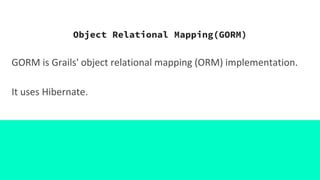This document provides an overview of Object Relational Mapping (ORM) using GORM in Grails. It discusses GORM basics like domain modeling with associations, persistence operations, and querying. Additional sections cover advanced topics such as events, custom mappings, and constraints.










![Many-To-One/One-To-One
Unidirectional
Bidirectional
class Face {
Nose nose
}
class Nose {
}
class Face {
Nose nose
}
class Nose {
static belongsTo = [face:Face]
}](https://image.slidesharecdn.com/gorm-180517114827/85/Gorm-11-320.jpg)
![When we save or delete the Face instance, GORM will save or delete the Nose. In other words, saves
and deletes will cascade from Face to the associated Nose:-
new Face(nose:new Nose()).save()
Now if we delete the Face instance, the Nose will go too:
def f = Face.get(1)
f.delete() // both Face and Nose deleted
To make the relationship a true one-to-one, use the hasOne property on the owning side, e.g. Face:
Note that using this property puts the foreign key on the inverse table to the example A, so in this case the
foreign key column is stored in the nose table inside a column called face_id. Also, hasOne only works
with bidirectional relationships.
class Face {
static hasOne = [nose:Nose]
}
class Nose {
Face face
}](https://image.slidesharecdn.com/gorm-180517114827/85/Gorm-12-320.jpg)
![One-To-many
A one-to-many relationship is when one class, has many instances of another class. With Grails you
define such a relationship with the hasMany setting:
In this case we have a unidirectional one-to-many. Grails will, by default, map this kind of relationship with a join table.
Grails will automatically inject a property of type java.util.Set into the domain class based on the hasMany setting. This can
be used to iterate over the collection:-
class Author {
static hasMany = [books: Book]
String name
}
class Book {
String title
}
def a = Author.get(1)
for (book in a.books) {
println book.title
}](https://image.slidesharecdn.com/gorm-180517114827/85/Gorm-13-320.jpg)
![The default cascading behaviour is to cascade saves and updates, but not deletes unless a belongsTo is
also specified:
class Author {
static hasMany = [books: Book]
String name
}
class Book {
static belongsTo = [author: Author]
String title
}](https://image.slidesharecdn.com/gorm-180517114827/85/Gorm-14-320.jpg)
![Many-to-many
Grails supports many-to-many relationships by defining a hasMany on both sides of the relationship and
having a belongsTo on the owned side of the relationship:
Grails maps a many-to-many using a join table at the database level. The owning side of the relationship,
in this case Author, takes responsibility for persisting the relationship and is the only side that can cascade
saves across.
class Book {
static belongsTo = Author
static hasMany = [authors:Author]
String title
}
class Author {
static hasMany = [books:Book]
String name
}](https://image.slidesharecdn.com/gorm-180517114827/85/Gorm-15-320.jpg)
![Composition in gorm
Grails supports the notion of composition. In this case instead of mapping classes onto separate tables a
class can be "embedded" within the current table.
class Person {
Address homeAddress
Address workAddress
static embedded = ['homeAddress', 'workAddress']
}
class Address {
String number
String code
}](https://image.slidesharecdn.com/gorm-180517114827/85/Gorm-16-320.jpg)





![Eager and lazy fetching
class Airport {
String name
static hasMany = [flights: Flight]
}
class Flight {
String number
Location destination
static belongsTo = [airport: Airport]
}
class Location {
String city
String country
}
def airport = Airport.findByName("Gatwick")
for (flight in airport.flights) {
println flight.destination.city
}
GORM will execute a single SQL query to fetch the Airport
instance, another to get its flights, and then 1 extra query
for each iteration over the flights association to get the
current flight's destination. In other words you get N+1
queries (if you exclude the original one to get the airport).](https://image.slidesharecdn.com/gorm-180517114827/85/Gorm-22-320.jpg)
![Configuring eager fetching
class Airport {
String name
static hasMany = [flights: Flight]
static mapping = {
flights lazy: false
}
}](https://image.slidesharecdn.com/gorm-180517114827/85/Gorm-23-320.jpg)







